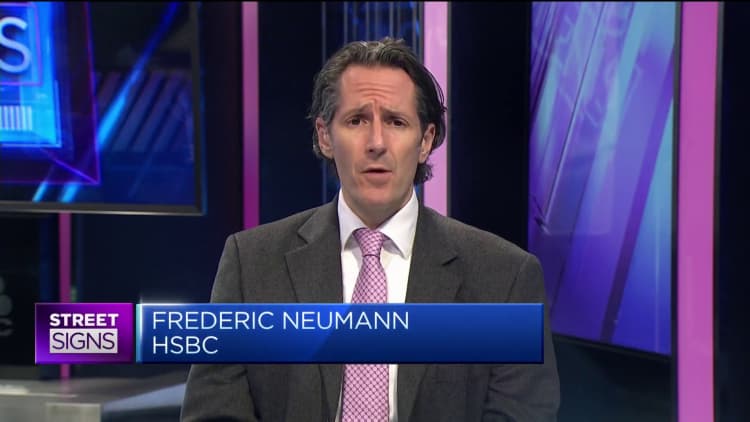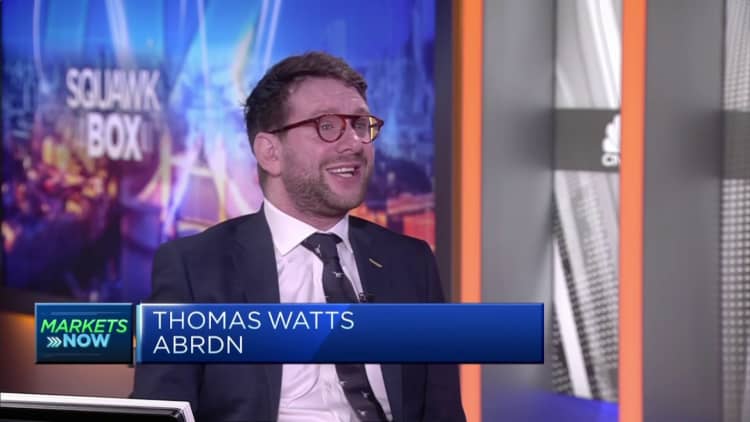
European Central Bank (ECB) President Christine Lagarde gestures as she speaks to the media following the Governing Council’s monetary policy meeting at the ECB headquarters in Frankfurt, Germany, December 14, 2023.
Kai Pfaffenbach | Reuters
The West’s major central banks all kept interest rates unchanged in recent days, but struck very different tones on the market’s much-anticipated cuts in 2024.
The U.S. Federal Reserve sent risk assets rallying on Wednesday when alongside holding its benchmark rate at its current target range of 5.25% to 5.5%, the Federal Open Market Committee revealed policymakers were penciling in at least three cuts next year and four additional cuts in 2025.
Markets are now pricing the first 25-basis-point cut in March and expect the Fed funds rate to be around 150 basis points lower by the end of next year, according to CME Group’s FedWatch tool.
Although the three cuts signaled by the Fed were still shy of the market’s expectations, it still presented a dovish surprise that sent the Dow to a record high and bond yields tumbling, with the 10-year U.S. Treasury yield falling below 4% for the first time since July.
U.S. headline inflation came in at an annual 3.1% in November, still above the Fed’s 2% target but down significantly from the pandemic-era peak of 9.1% in June 2022. However, the core figure — which strips out volatile food and energy prices — held steady at 4%.
Meanwhile economic activity has remained remarkably resilient, with GDP growing at an annual 5.2% in the third quarter.
Fed Chair Jerome Powell acknowledged in his press conference on Wednesday that rate cuts had now begun to “come into view,” prompting a number of economists and major lenders to change their future rate calls.

Among them were U.S. economists at Barclays, who had previously projected just a single rate cut in December 2024, but now expect three cuts at every other meeting, starting from in June.
“We were surprised by the FOMC’s reluctance to push back against the notable easing of financial conditions over the past month or so,” they said.
“Not only did the statement cite ‘tighter financial and credit conditions…’ as in November, but the SEP [summary of economic projections] also showed a slightly downgraded GDP growth projection for 2024 despite less restrictive conditions for aggregate demand. Powell expressed no concern that such easing might undermine the FOMC’s objectives.”
Despite the dovish shift in the rate call, the British lender’s economists assigned upside risk to its projections as the recent easing in financial conditions “may boost growth and ultimately result in stalling disinflation.”
A more perilous picture in the UK
On the other side of the Atlantic, however, the picture is very different. Both the Bank of England and the European Central Bank on Thursday pushed back against market expectations, drawing attention to persistent domestic price and wage pressures.
The Bank of England kept its main interest rate unchanged at 5.25% but far from putting rate cuts on the table, said monetary policy is “likely to need to be restrictive for an extended period of time.”
U.K. headline inflation fell to an annual 4.6% in October, its lowest point in two years but well above the Bank’s 2% target. Meanwhile wage growth has also undershot expectations of late, but at more than 7%, still remains uncomfortably high for the central bank.
The BOE’s Monetary Policy Committee noted that “key indicators of U.K. inflation persistence remain elevated,” although tighter monetary policy is leading to a looser labor market and weighing on activity in the real economy.
Real U.K. GDP was flat in the third quarter but the economy unexpectedly shrank by 0.3% month-on-month in October.

S&P Global said the BOE still faces a tough task in determining the appropriate point to start loosening, especially given that it has been accused of being slow off the mark to tackle runaway inflation, which peaked at 11.1% in October 2022.
Principal Economist Raj Badiani said the 6-3 voting pattern in favor of holding rates steady on Thursday, with the three dissenting members favoring another 25 basis point hike, indicates that the MPC is not yet ready to consider rate cuts against a backdrop of stubborn service inflation, which has placed regular earnings growth on a “troublesome trajectory.”
“We expect four interest rate cuts next year with the first to occur in August 2024. However, we acknowledge that this could be impacted adversely because of still strong service and core inflation and unsustainable earnings growth,” Badiani said.
“Monetary policy is very restrictive which is likely to trigger a mild recession in the coming quarters. In addition, the economy is likely to contract marginally in the full-year 2024.”
ECB to stay ‘sufficiently restrictive’
The European Central Bank also held rates as it revised down its growth and inflation forecasts and announced plans to speed up the shrinking of its balance sheet.
“The Governing Council’s future decisions will ensure that its policy rates will be set at sufficiently restrictive levels for as long as necessary,” the ECB said in its accompanying statement.
However, it did shift its language in describing inflation from “expected to remain too high for too long” to an assertion that it will “decline gradually over the course of next year.”
Euro zone year-on-year inflation has moderated from 10.6% in October 2022 to 2.4% in the most recent reading in November, putting the ECB’s 2% target within reach even as officials warn that wage pressures and energy market volatility could trigger a resurgence.

Although there were near-term downgrades to the ECB’s inflation forecasts, 2025 core inflation was surprisingly revised upward, and the ECB’s new 2026 forecasts still put core inflation above target at the end of the projection horizon.
“Despite the hawkish messaging at [Thursday’s] meeting, the recent run of softer than expected inflation data, the Fed’s pivot, as well as the softening in rhetoric from a number of prominent members on the Governing Council, has shifted the balance of risks around the ECB’s policy trajectory,” said Peter Schaffrik, global macro strategist at RBC Capital Markets.
“While we continue to expect that the ECB will keep rates unchanged in 2024, we think that the risks are now tilted firmly towards earlier rate cuts.”
However, interpretations of ECB President Christine Lagarde’s press conference varied. Although she pushed back on market expectations for a first move as early as March, some economists viewed the overarching message as opening the door for rate cuts at some stage in 2024.
“While [Lagarde] emphasised that the ECB’s approach is data-dependent rather than time-dependent, she dropped at least four hints suggesting that a first cut seems more likely from June 2024 onwards rather than in early 2024,” said Berenberg Chief Economist Holger Schmieding.
These hints were: a reference to a “plateau” between the last hike and the first cut; an emphasis on the resilience of domestic and mostly wage-driven inflation; a reminder that ECB projections for headline inflation to fall to 2.1% in 2025 are based on market expectations for 3-month average overnight interest rates, which cut off at Nov. 23, rather than current market pricing; and a deluge of new data due in the first half of 2024.
“Tellingly, the ECB monetary policy statement did not change the wording on the rate outlook. As before, the ECB vowed to set rates at ‘sufficiently restrictive levels for as long as necessary’ to ensure a return of inflation to the 2% target. We continue to expect a first 25bp cut in Q3 2024,” Schmieding said.
